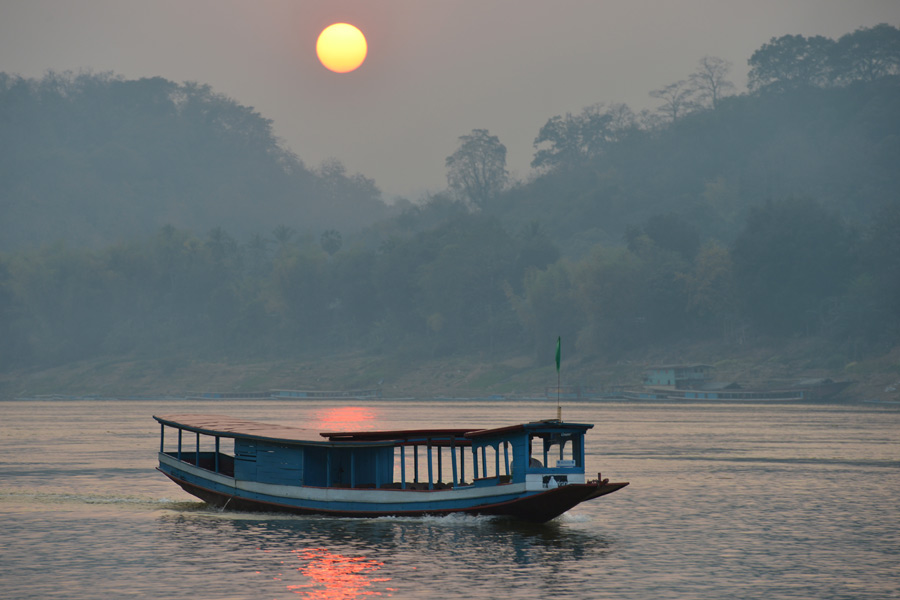[fshow photosetid=72157658916059901]
The Mekong River has for centuries played a vital role in shaping Southeast Asian civilisations. A source of food and water as well as an important cultural and, in some cases, religious institution, the river gives life to millions of people in this part of the world, from its source in the Tibetan plateau all the way through China, Burma, Thailand, Laos, Cambodia and Vietnam. In the small communities that sustain themselves from fishing in the river and irrigating their fields, visitors are greeted with the well-known hospitality and friendliness of the Lao people. Guests are often invited to the village where they can experience the daily life of a local fisherman or hear about local customs and traditions.
Luang Prabang and Pakse
One of the most popular destinations along the Mekong River is Luang Prabang. The old part of the city became a UNESCO World Heritage site in 1995 due to its fusion of traditional architecture and Laos structures with those built by the Europeans during colonial rule in the 19th and 20th centuries. The well-kept town centre serves as a live museum as it blends these two distinct cultural traditions. There are plenty of charming cafes and hang outs and in recent years a number of galleries and retreats have also appeared. Luang Prabang is becoming a premier lifestyle destination not only for travellers from abroad but also a weekend getaway for people living in nearby large cities such as Hanoi, Bangkok and Singapore.
A tour along the Mekong River in Laos will often involve a visit to Pakse, which is the provincial capital of Champasak province in the southern part of the country. Often referred to as the gateway to the Bolaven Plateau, which is rich in natural beauty, the town is a perfect destination for nature lovers looking for waterfalls, hills, green valleys and coffee plantations. Pakse is also the home of Wat Luang, a Buddhist temple where visitors can witness the giving of alms to the monks as part of a daily ritual in Buddhist life. On the grounds of the temple is a large white and gold stupa, typical of Buddhist temples all over Southeast Asia.
UNESCO World Heritage Site
The Champasak Provincial Museum is also worth a visit when touring around Pakse. Although not very large, the museum displays various artefacts telling the unique story of the province. Old photos, musical instruments, pottery, jewellery, ethnic clothing and textiles all tell a fascinating story of the southern province.
Just six kilometres from the Mekong River in Champasak province lies the ruined Khmer temple complex Wat Phou at the foot of Phu Kao mountain. One of the oldest archaeological sites in Laos, the temple is a centre for Therawada Buddhism and was part of the vast Khmer empire. Like most temples Wat Phou faces to the east although the orientation of the mountain and the river means the temple is actually slightly off course. In 2001 it was listed as a UNESCO World Heritage site for its significance to religious history in Southeast Asia.
Giver of Life
The Mekong River, or the ‘mother of all rivers’ as it is commonly referred to in some languages on the Southeast Asian mainland, is the giver of life not only to humans living along its banks, but also to an extremely diverse plant and animal world. From the cold climate of the Tibetan plateau to the tropical surroundings of Laos, Cambodia and Vietnam, the river and the greater subregion around it is home to no less than 20,000 plant species, 430 mammals, 1,200 bird species and an estimated 850 fish species.
The rich natural surroundings and the traditional river communities make the Mekong River a popular tourist attraction in itself, and many visitors to Southeast Asia will at some point or another come in contact with the river, whether by sitting at a riverside eatery in the former royal capital of Luang Prabang in the north, or cruising it in a traditional river barge in the south. The ever changing landscape, the natural flow of the river and the smiles and waves of the locals as you drift past is refreshingly different from some of the regions crowded beaches and bustling cities.
Tips:
- Lao cuisine is similar to other Southeast Asian cuisines in the use of fresh herbs and plenty of spices. Some of the most common ingredients are chilli, lime, lemongrass, fish sauce and sticky rice, which is a glutinous rice that becomes sticky when cooked.
- For up to date information and inspiration to your stay in Luang Prabang and to read more about the old city’s attractions, visit http://www.tourismluangprabang.org/
- For a unique experience, try to rise with the sun and watch monks in bright orange robe stroll through the streets of small towns to collect alms. It’s a sight to behold.

